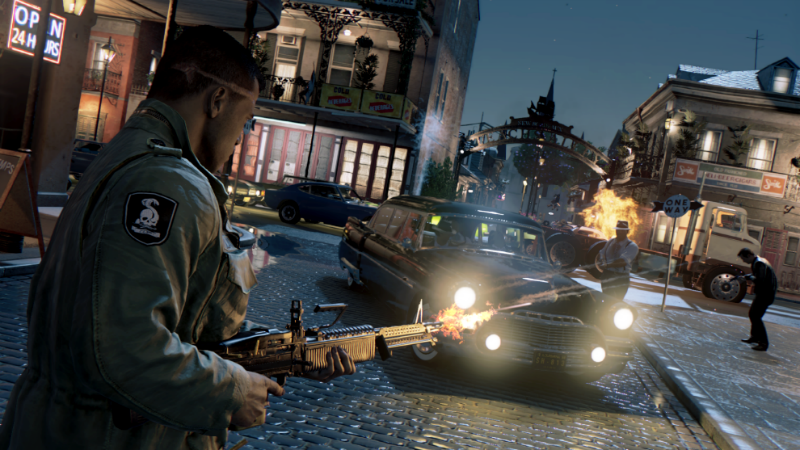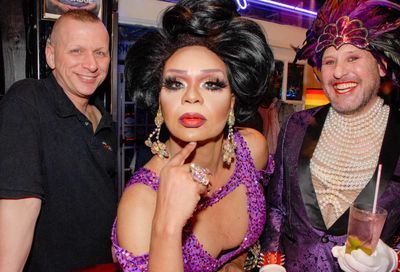Mafia III (review): Brilliant narrative, repetitive gameplay
It's easy to get lost in Mafia III's world. It's just a shame that various shortcomings threaten to pull you out of it.

Rockstar Games has ruined the gaming industry. Okay, that’s a bold statement, but the maker of Grand Theft Auto has been churning out variations on open world games for well over a decade now and the template they’ve established has gradually seeped into other studios.
GTA established the tried-and-tested point A to point B method of mission structure that almost every other game of this type follows, and unfortunately Mafia III (![]()
![]()
![]() ) is no exception. What starts as a beautiful, original, punishingly real oratory into the African American mob experience during the turbulent ’60s in the American South quickly devolves into a me-too clone of the most tedious aspects of Rockstar’s towering franchise.
) is no exception. What starts as a beautiful, original, punishingly real oratory into the African American mob experience during the turbulent ’60s in the American South quickly devolves into a me-too clone of the most tedious aspects of Rockstar’s towering franchise.
It’s a shame, as the opening few hours really are phenomenally good. Set in New Bordeaux, a thinly reskinned New Orleans, in 1968, Mafia III is as much about the politics and social norms of that period as it is a game about criminal empires, with racism and anti-Vietnam sentiment mixing with civil rights struggles and an explosion of incredible music. It’s a wonderful backdrop, a welcome shift from the ’30s and ’40s settings of the first two games, and it’s also remarkably timely: New Bordeaux is a city struggling with white supremacy, racial tension, social divide and class struggles, not unlike the current climate whipped up by an orange presidential candidate.
As Lincoln Clay, a mixed-race, special forces-trained Vietnam veteran, gamers also have the opportunity to experience a game as something other than a cookie-cutter white guy. Raised by the leader of the city’s African American mob, Lincoln is battle-hardened and ruthlessly efficient at dispatching his foes, but when he returns from war at the game’s start he looks forward to nothing more than moving to California and getting a proper, workaday job in construction. That all falls to the wayside when it becomes clear that Sammy, his adoptive father, is indebted to New Bordeaux’s ruthless Italian mafia.

After an inevitable double cross (this is the mafia, after all) that leaves Lincoln scarred and burning with rage, Mafia III makes clear the player’s ultimate goal. You won’t be doing the rags-to-riches story of the previous two games or pretty much every other GTA-like open world game. Lincoln doesn’t want wealth. He wants control, power, revenge. Players won’t be rising up the ranks — instead, they’ll be murdering their way through them, systematically destabilizing mafia Don Sal Marcano’s criminal empire until justice has been rightfully done.
For those worried that Mafia III is trying to be too different from the previous entries in the series, rest assured that developer Hangar 13 has crafted a masterwork of a narrative to accompany your time in New Bordeaux. Characters are fully realized, from Clay himself to his three underbosses: Cassandra, the leader of the Haitians, Vito Scaletta, who returns from Mafia 2 after fleeing the mob, and Thomas Burke, who lost his son in the double cross that fuels Lincoln’s quest. Conversations are natural, performances are top-notch, and there are some incredible facial animations at work. The eyes of the main characters in particular are eerily convincing at conveying emotion: When Cassandra tells of how her sister perished at the hands of the city’s racist Dixie Mafia, tears form realistically under her eyes. It’s an added punch of emotion that drives home the darker aspects of Mafia III‘s story.

It’s a detail that also extends to New Bordeaux itself. Each area in the city feels distinct, lived-in. The French Ward is alive with jazz and color, skyscrapers and suits fill Downtown, Delray Hollow — a predominantly black district — is clearly different to Frisco Fields, where the city’s middle class (and white) residents live. Gators and mist fill the swampy Bayou Fantom, while industry thrums away in Barclay Mills. Hangar 13 nailed the aesthetic of the time, from the clothes to the hair, the advertisements to the automobiles that fill streets. Sports cars and big sedans glide past mansions in wealthier districts, while beaters and compacts hug dilapidated sidewalks in poorer areas.
Hangar 13 also didn’t shy from horrific, ingrained racism of the time. Pedestrians, enemies, police officers and random encounters will all use racial slurs with gay abandon. What’s worse is that it never feels egregious, as though the developers want nothing more than to shock. Instead, it feels natural, as though these digital recreations have been raised from birth with an “us versus them” mentality that finds its way into the world through the n-word and other such means. Walk along a street and white pedestrians will shuffle out of your way or throw suspicious glances. Shop owners will call the police if Lincoln lingers too long. Police will drop everything to glare as you drive past. Steal a car in a white neighborhood and they’ll devote everything to bringing you down — steal from a black resident and you’ll be lucky to even raise an official eyebrow. It’s shocking at first, a reminder of a time we’re not far removed from (and worryingly close to returning to), but if anything it also underscores just how satisfying the game’s brutal combat can be. Eavesdrop on two people discussing how inferior black people are to whites and you won’t think twice about sinking your knife into their necks or a bullet into their skulls.

That morality — or lack thereof — pervades Mafia III‘s gameplay. Lincoln is ruthless in his quest for vengeance, handling guns, projectiles, knives, and his fists to devastating effect. The ease with which players can dispatch foes is as much down to Lincoln’s effective combat training as it is familiar gameplay mechanics that we’ve seen in hundreds of other games. Unfortunately, that’s where Mafia III starts to slip. It is primarily a cover-based shooter, blending stealth and combat. Players can hide behind objects, choosing to attract enemies and dispatch them quietly, or engage in active gunfire. It’s a system that works, and works well, but does little to innovate. It’s not helped that enemy AI is stupidly predictable. Two people will typically stand together — get close enough and they’ll engage in a conversation then break off, heading in different directions. Pick them off and then move on, rinse and repeat. If you opt for the gun’s blazing approach, enemies will crowd en masse, but they’ll still pop up at set times, or stumble blindly into your bullets, or leave themselves deliberately open for dispatching. This isn’t Assassin’s Creed or Hitman, but it also can’t match more polished, gunplay-focused games either. It’s also telling that those who want to choose a less murderous path will find their decision left to a menu option — rather than holding a button for a stealthy, nonlethal takedown, it’s an on-off switch in the options. Mafia III makes it clear that Lincoln is a killer above all else.
It’s not helped by a mission structure that quickly devolves into repetition. You’ll be tasked with taking over New Bordeaux district by district, working to destabilize whatever criminal operation exists there: prostitution, drug trafficking, stolen goods. You’ll interrogate underlings, destroy property, kill thugs and eventually work your way to the boss of that particular local. You’ll then kill them or recruit them to your growing empire, and assign their particular racket to one of your three underbosses. Doing so unlocks new perks with each underboss — Cassandra can block phone lines and provide guns, for instance, while Burke can supply explosives and cars. Underbosses must be placated with new regions and side missions; ignore them for too long and they’ll turn on you, which adds an interesting twist to the narrative. Players can experience multiple outcomes from the main story depending on who they have with them, so there’s incentive to replay and see how your choices impact Lincoln’s rise to power.
Unfortunately, getting there is a slog. Every mission boils down to Grand Theft Auto at its worst. Drive here, kill these people interrogate someone/destroy something/kill a boss, then return to whomever assigned the mission. There are occasional highlights — a shootout at a creepy, abandoned theme park filled with white supremacists sticks in the mind — but you’ll see too many recycled interiors as you work through New Bordeaux’s criminal underworld. You’ll even return to the same locales — an early mission asks you to clear out an old theater twice, for seemingly no good reason.

Mafia III also struggles because Hangar 13 never seems happy to just leave you to explore the world it has created. All of New Bordeaux is open from the game’s outset, but there’s very little to do beyond marvel at its authentic feel. There are a smattering of collectibles, but outside of the main story missions there’s little to pull focus. If you do grab a car and enjoy the game’s arcade-style, Hollywood-influenced driving, you’ll also start to see the technical limitations of New Bordeaux. While it is often beautiful, a pervasive haze hangs over the city, the draw distance is far too short (textures and objects pop into existence not far from Lincoln), the lighting system varies between dramatic and comically confused, and textures and details look muddy if you inspect them too closely. It’s not helped by a user interface that feels more at home in Watch Dogs than a game set in the ’60s. Given the attention to period detail in other aspects, it’s odd that Hangar 13 went for such crisp, clean, modern elements. Bugs also abound in the game’s day and night cycle, which never seems to consistently transition. Sometimes you’ll get a breathtaking sunrise, other times you’ll walk around a building and the game will randomly transition from dark and stormy to penetrating sun.
The way Mafia III tells its story also suggests that you should be working your way through it, not getting out and seeing what’s on offer. It’s presented as a wonderfully acted documentary, with characters in the game telling Lincoln’s tale and the game itself an extended flashback of sorts. Think Assassin’s Creed, but without the confusing sci-fi pretentiousness. But the result is that you won’t transition between missions naturally like Grand Theft Auto, for instance. Instead, Mafia III is all too happy to yank players from the moment or snap to a cutscene, before depositing them elsewhere and gently prodding them to get on with Lincoln’s quest for revenge. It’s a stop-start method of storytelling that seems at odds with the open world crafted for it to exist in.
That said, when Mafia III gets it right, it really works. The immersion, the awfulness of New Bordeaux shines through the various cracks in Mafia III‘s gameplay and engine. Lincoln Clay is a fully realized character, his motives are clearly defined, his narrative is told with deft writing. He’s an antihero, someone we want to succeed, but whose methods of achieving success are as horrible as they are justifiable. Mafia III takes the Italian mob glorified in the first two games, wraps it in a dense layer of racism and injustice, and then hands players the tools to help it burn to the ground.
When the glorious soundtrack — filled with Jimi Hendrix, Steppenwolf, Beach Boys, Rolling Stones, and Aretha Franklin among dozens of others — kicks in and the world of New Bordeaux extends around you, it’s easy to get lost in Mafia III‘s world. It’s just a shame that its various shortcomings consistently threaten to pull you out of it.
Mafia III is available on PC, PS4 and Xbox One. Visit Amazon.com or GameStop.
Support Metro Weekly’s Journalism
These are challenging times for news organizations. And yet it’s crucial we stay active and provide vital resources and information to both our local readers and the world. So won’t you please take a moment and consider supporting Metro Weekly with a membership? For as little as $5 a month, you can help ensure Metro Weekly magazine and MetroWeekly.com remain free, viable resources as we provide the best, most diverse, culturally-resonant LGBTQ coverage in both the D.C. region and around the world. Memberships come with exclusive perks and discounts, your own personal digital delivery of each week’s magazine (and an archive), access to our Member's Lounge when it launches this fall, and exclusive members-only items like Metro Weekly Membership Mugs and Tote Bags! Check out all our membership levels here and please join us today!





















